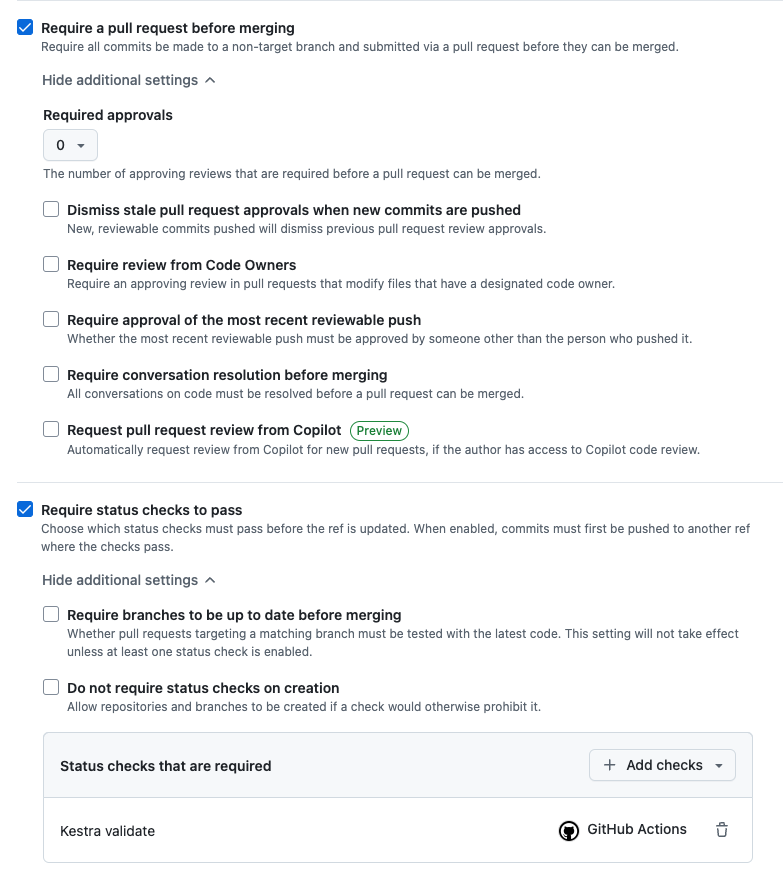 Validate and Deploy your Flows with GitHub Actions
Validate and Deploy your Flows with GitHub Actions
Available on: >= 0.6.1
How to use GitHub Actions to automatically validate and deploy your flows to Kestra.
If you're version controlling your Flows inside of a Git repository, it can be useful to automatically validate that they're in the correct format before merging into your main branch. On top of that, you can automatically deploy your flows in your main branch to your Kestra instance.
There are 2 GitHub Actions available:
- Validate - Validate your flows and templates before deploying anything.
- Deploy - Deploy your flows and templates to your Kestra server.
Validate Your Flows
Using the Validate Action, we can set up our workflow to check all flows inside of the directory specified when a commit is pushed to main or a Pull Request is opened for the main branch. For the full list of inputs, check out the reference here.
In the example below:
- Triggers when a commit is pushed to
mainor when a PR is opened for themainbranch. - Checks out the repository so we can access the files in later steps.
- Uses the Validate Action to check all the flows inside of the
./kestra/flowsdirectory.
name: Kestra CI/CD
on:
push:
branches: [ "main" ]
pull_request:
branches: [ "main" ]
jobs:
validate:
runs-on: ubuntu-latest
name: Kestra validate
steps:
- name: Checkout repo content
uses: actions/checkout@v4
- name: Validate all flows on server-side
uses: kestra-io/validate-action@master
with:
directory: ./kestra/flows
resource: flow
server: https://server-url.com
Deploy Your Flows
Using the Deploy Action, we can set up our workflow to deploy when new commits are pushed to our main branch. Like the Validate Action, we will need to specify a directory and resource, which includes namespace files too. For the full list, check out the reference here.
On top of that, we need to specify the namespace that these flows will be deployed to. We can only chose one namespace meaning if we want to deploy multiple namespaces, we will need to add multiple steps using the Deploy Action.
In the example below:
- Triggers when commits are pushed to
main. - Checks out the repository so we can access the files in later steps.
- Deploys flows inside of
kestra/flowsto thecompany.teamnamespace in the Kestra instance.
name: Kestra CI/CD
on:
push:
branches: [ "main" ]
jobs:
deploy:
runs-on: ubuntu-latest
name: Kestra deploy
steps:
- name: Checkout repo content
uses: actions/checkout@v4
- name: Deploy flows
uses: kestra-io/deploy-action@master
with:
namespace: company.team
directory: ./kestra/flows
resource: flow
server: https://server-url.com
Authentication
If you have authentication enabled in your Kestra instance, you will need to add additional properties so your action can authentication with your instance. If you have basic authentication enabled with a username and password (e.g. on the Open Source Edition), you can add the user and password properties to your Action using Secrets:
name: Kestra CI/CD
on:
push:
branches: [ "main" ]
jobs:
deploy:
runs-on: ubuntu-latest
name: Kestra deploy
steps:
- name: Checkout repo content
uses: actions/checkout@v4
- name: Deploy flows
uses: kestra-io/deploy-action@master
with:
namespace: company.team
directory: ./kestra/flows
resource: flow
server: https://server-url.com
user: ${{ secrets.user }}
password: ${{ secrets.password }}
As you can see, the user and password are added as secrets with the expression syntax ${{ secret.name }} to prevent you from committing these to your repository.
If you're using the Enterprise Edition, you can use an API Token instead:
name: Kestra CI/CD
on:
push:
branches: [ "main" ]
jobs:
deploy:
runs-on: ubuntu-latest
name: Kestra deploy
steps:
- name: Checkout repo content
uses: actions/checkout@v4
- name: Deploy flows
uses: kestra-io/deploy-action@master
with:
namespace: company.team
directory: ./kestra/flows
resource: flow
server: https://server-url.com
apiToken: ${{ secrets.KESTRA_API_TOKEN }}
Set Up a Branch Ruleset
If you're working in a team, it can be useful to set up a Ruleset on your main branch to prevent broken flows from being deployed accidentally to your production instance.
To enable this, go to the Settings of your repository on GitHub and go to Rules then Rulesets. In here, we can create a new branch ruleset.
The goal of this ruleset is to protect the main branch as our GitHub Action will automatically deploy any flows in this branch to our Kestra instance. To achieve this, we can set the specific Branch rules:
- Require a pull request before merging - No commits can be made directly to the
mainbranch - Require status checks to pass - Requires our Validate Action to pass before we can merge our Pull Requests

With these enabled, we are required to make a Pull Request before our flows end up in production. This enables us to run our validate check and require that to pass before we can merge any pull requests.

In the example above, the flow was had an incorrect indentation so it failed the validate check. As a result of this, the Pull Request is unable to be merged until it is fixed.
Was this page helpful?